In our recent webinar ‘Reopening Amid the Pandemic - Adaptability is Key’ Global Guardian CEO Dale Buckner, Director of Intelligence Michael Ballard, and Medical Leadership - Dr. Shelly Weisenfeld and Dr. Chris White shared insight on navigating through the COVID-19 pandemic. Read through their advice and answers to the top 15 questions below.
Q: What is the current state of the pandemic in the United States?
As of mid-July, the United States had the world’s highest number of confirmed cases of COVID-19 (more than 4.5 million) and the highest number of related deaths (more than 150,000). “As far as the big picture goes, it is a generally negative trend in the US,” says Mike Ballard, Director of Intelligence at Global Guardian. He notes that pandemic hot spots in the United States are shifting away from the Northeast—New York, New Jersey, and Connecticut—to the Midwest and the South. Many states like Arizona, California, Florida, and Texas that rushed to reopen have had to backtrack in the face of a spike in infections. “You are seeing a lot of states pause reopening or they are rolling back openings,” says Ballard.

The worst may be yet to come. US Centers for Disease Control and Prevention (CDC) Director Robert Redfield predicts that the coexistence of the novel coronavirus, which causes COVID-19, with the flu virus will make the fall and winter “probably one of the most difficult times that we’ve experienced in American public health.”
To make matters worse, coronavirus testing is “not really keeping up,” says Ballard, pointing out that adequate contact tracing infrastructure is also not in place. Instead of focusing on tracing, isolation, and lockdowns, he says, “much of the resources are going into vaccine development.”
Q: When will the United States reopen?
That’s the million-dollar question. Global Guardian Chief Executive Officer Dale Buckner acknowledges that earlier predictions about reopening in the fall were too optimistic. “I am less optimistic today here in July than I was back in April or May,” says Buckner. “It is unfortunate, but it is our reality.”
“We, as an organization,… feel a little less optimistic that we were going to stand up to a new normal by this fall across the country. That is TBD,” Buckner says, adding, “How we start to operate globally remains TBD.”
Buckner recommends a month-by-month evaluation of data. “The end state here is we have to find our way to this new normal,” he says. But, he acknowledges, the highly charged political environment in the country during an election year could complicate things. “We might be stuck in this situation for much longer than we think,” he warns.
Michael McGarrity, Vice President, Global Risk Services at Global Guardian, says: “As countries, companies, organizations, and schools formulate their plans to reopen, adaptability will be key.”

Q: Is it safe to return to the office before a vaccine is developed?
Many companies are encouraging their employees to work from home—at least until 2021. Twitter Chief Executive Officer Jack Dorsey says the social media company’s employees will be allowed to work from home “forever.”
“Big banks, finance, tech sectors… if you are in a professional services environment, just keep working remote,” advises Mike Ballard, Director of Intelligence at Global Guardian.
Shelly Weisenfeld, Medical Director at Global Guardian, says it is best to look at staying safe as an exercise in risk reduction. “We just need to have an honest conversation about how much risk we are willing to take, how to be responsible to self and to society. But to await a vaccine to get a green light to return to work, I believe, is an economic disaster,” she says.
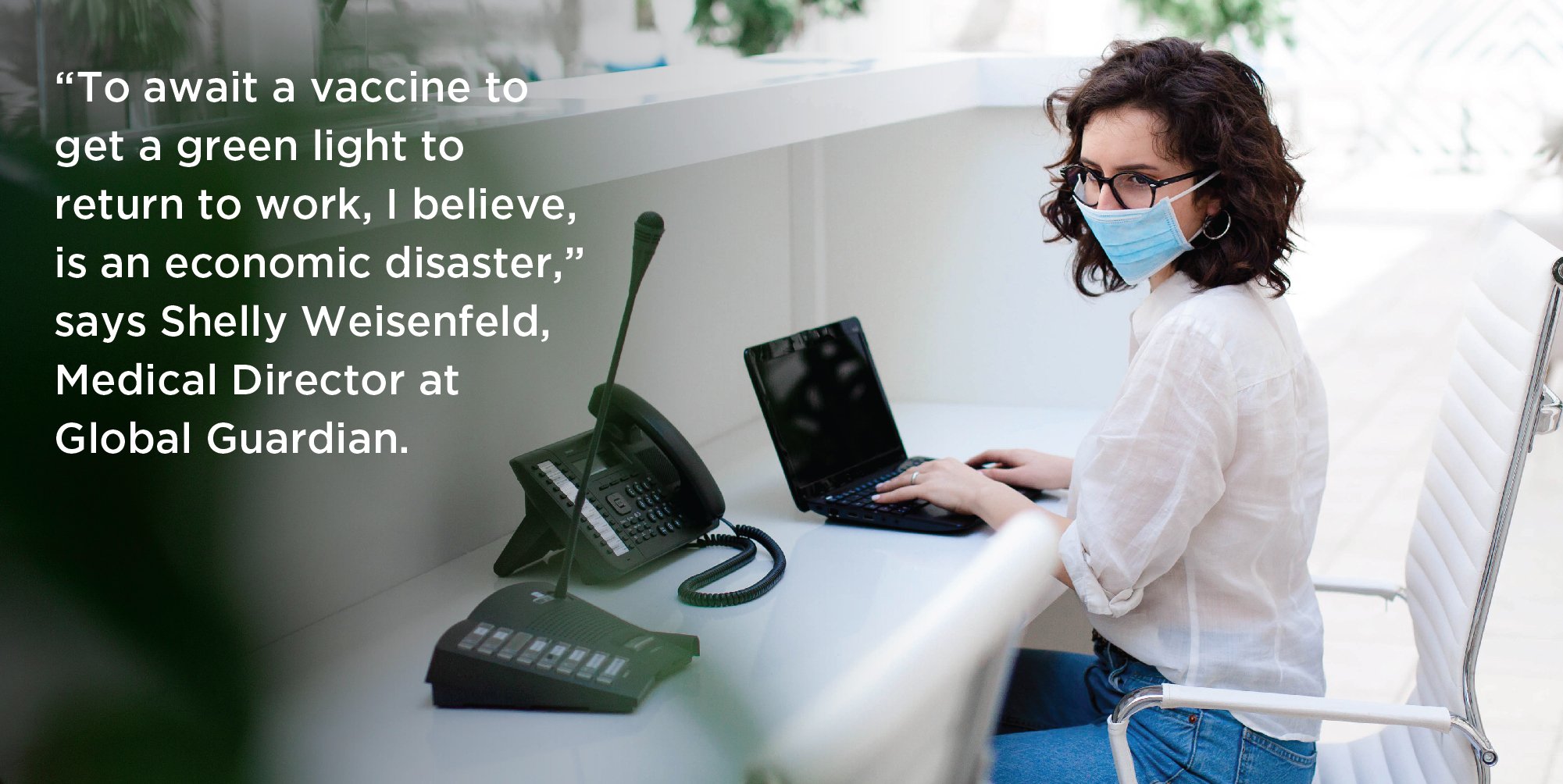
Christopher N. White, Assistant Medical Director at Global Guardian, agrees that waiting for a vaccine is simply not realistic. He says returning to the office is a “very individualized decision.” He suggests the following questions should be considered before returning to the office: is it practical to return to the office, can I continue to work from home, am I in a high-risk category, does my job require me to be in the office, and what happens if I fall sick? “We are going to have to start pushing toward some version of normalization and just making that risk-benefit analysis for yourself and for your family,” says White.
Q: What should employers consider as they decide whether to ask their employees to return to the office?
Shelly Weisenfeld, Medical Director at Global Guardian, says the focus right now needs to be on making the workplace safe. This includes looking at ventilation in office buildings and air circulation in elevators. The fact that the coronavirus is airborne raises concerns about the safety of HVAC systems. The American Society of Heating, Refrigerating and Air-Conditioning Engineers (ASHRAE) has developed guidance to address these concerns. Many new technologies are also being considered to make the workplace safer.
Then there is the question of who actually needs to be in the office. “If you can identify who is key and essential it answers a lot of the puzzle right up front,” says Global Guardian Chief Executive Officer Dale Buckner. At Global Guardian, Buckner says, employees have been split up into Teams A, B, C, and D. Those on Team D may never need to be physically present in the office—at least for the foreseeable future.

Buckner says that if you implement the right systems, protocols, and policies; identify key and essential personnel; and operate within that construct, you can operate safely and go to work at some level. “It all comes back to policy, procedure, and identifying key and essential” personnel, he says.
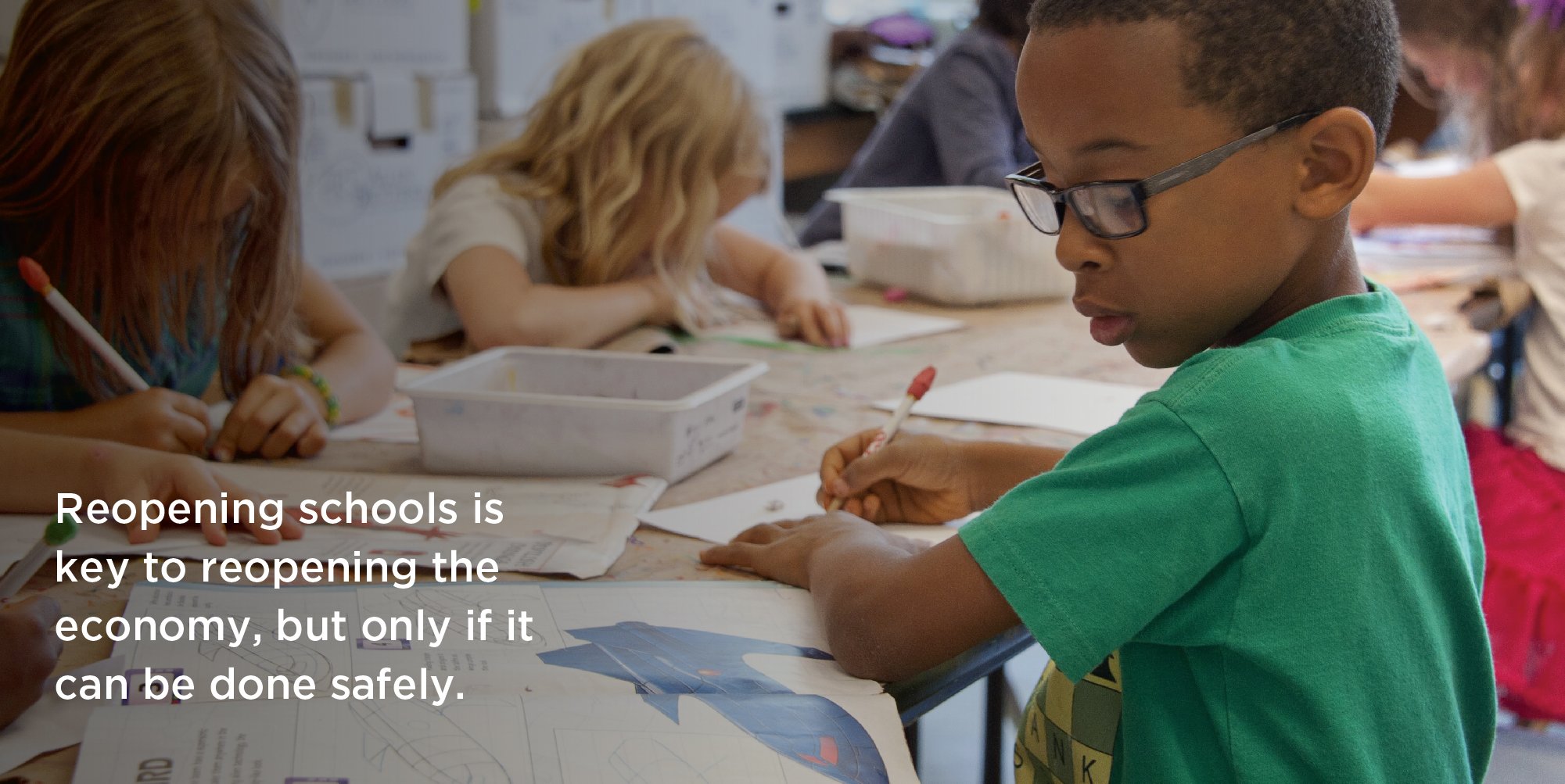
Q: Is it safe for kids to go back to school in the fall?
The fate of schools is a hot topic of discussion this summer. Reopening schools is key to getting the economy moving again—provided it can be done safely. People who have kids at home are struggling to juggle fulltime jobs with childcare responsibilities. But the decision to reopen schools in the midst of a pandemic is an extremely difficult one. Returning kids to classrooms where social distancing and mask wearing will be a challenge is risky and teachers are worried about being “sacrificed” for the sake of the economy.
Some school districts across the country are choosing not to offer in-person learning in the fall and will continue with virtual learning. Other school districts are considering the option of hybrid learning—a mix of online and in-person learning. The American Academy of Pediatrics, meanwhile, is advocating sending kids back to school for the sake of their mental and physical well-being.
The US Centers for Disease Control and Prevention (CDC) has delayed the release of new recommendations for sending children back to school.
Q: Do I really need to wear a mask?
Health experts agree wearing a mask cuts the risk of transmission of the novel coronavirus, an airborne respiratory virus. Getting people to wear a mask, however, has proven to be a challenge in the United States.
In states that had limited shutdowns in response to the pandemic—Alabama, Florida, and Texas, for example—“mask adoption is really now becoming a cultural and political issue,” says Mike Ballard, Director of Intelligence at Global Guardian. This, he says, has created a “barrier to slowing the spread” of COVID-19. “The longer it takes folks to adopt [the guidance on wearing masks]… the longer it is going to take to get things back to normal,” he says.
Global Guardian Chief Executive Officer Dale Buckner says of the health and safety guidelines: “We still don’t have adoption. You can’t force that. We can only educate and we can only put out best practice… We are doing our best to be consistent with that message.”
“This is what we have: [social] distancing, the masks, the temperature checks, the screening, isolation, tracing. Those are the weapons that we have. The quicker that the nation adopts it, the quicker we will have some level of normalcy that we can then start to open back up,” Buckner says.
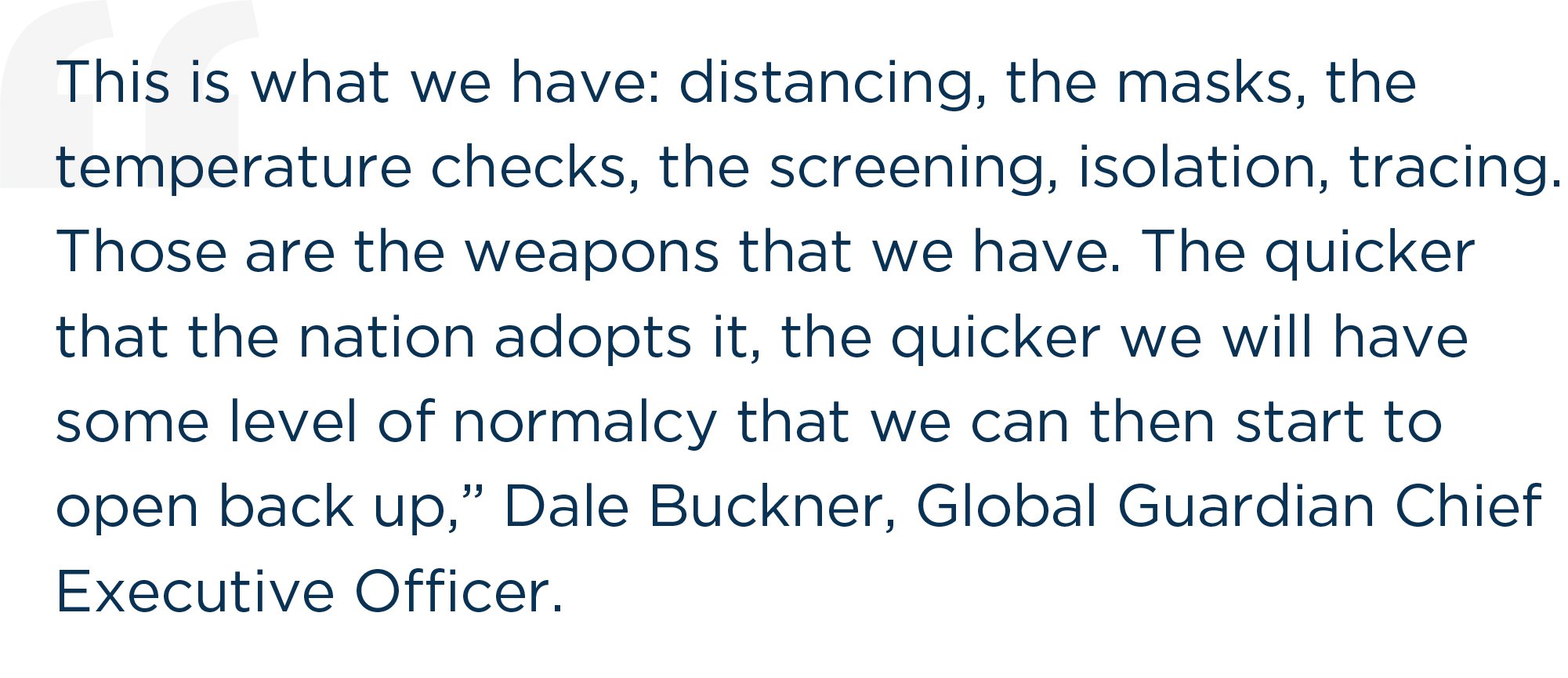
In the early days of the pandemic, some health officials, including the US Surgeon General, said masks were not effective in stopping the spread of COVID-19. Ballard says such statements were an attempt to prevent a run on N95 masks and to ensure that healthcare and essential workers had adequate supplies of personal protective equipment.
Q: Where in the world can a US citizen travel?
On July 1, the European Union prohibited US residents from entering Europe citing high rates of COVID-19 in the United States. “As far as international travel goes, we are sort of persona non grata now,” says Mike Ballard, Director of Intelligence at Global Guardian. “Until the situation gets a little bit more under control here you are not going to see a lot of countries be willing to open up to travel.”
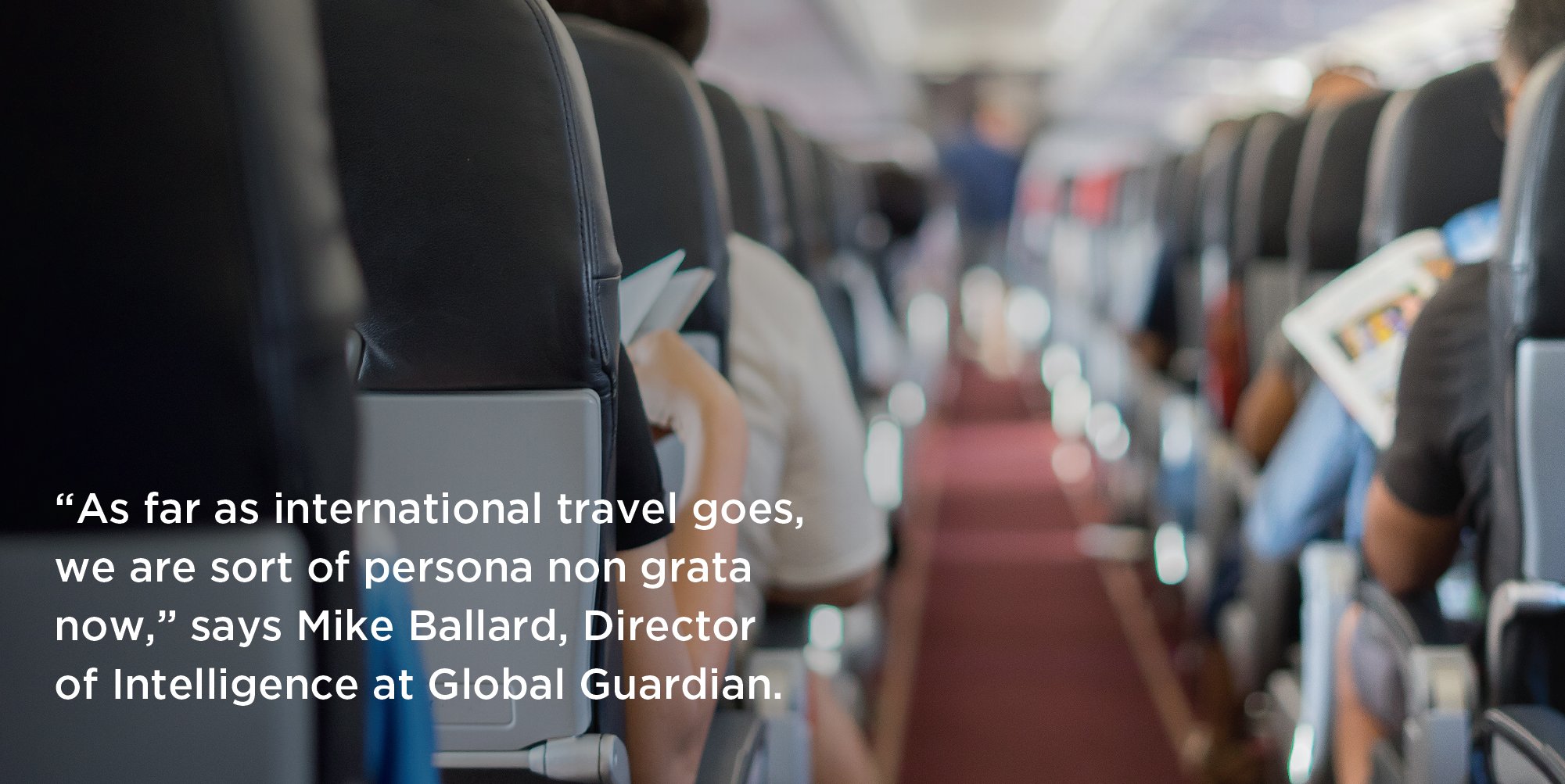
Not every country in the world is off limits to US citizens. US citizens are, for example, allowed to travel to Ireland and the United Kingdom, which are outside Europe’s Schengen Area, but are required to undergo a mandatory 14-day quarantine on arrival.
While some exceptions may be made for business travelers from the United States who are “in and out in a 24-hour period” that comes with a lot of bureaucracy, says Ballard. Many countries now require proof of a negative COVID-19 test taken within 72 hours of arrival. A failure to produce this will lead to a 14-day quarantine in a government-run facility.
The US State Department warns US citizens against international travel during a pandemic.
Q: What should I consider when planning to travel abroad?
Global Guardian’s clients are flying into Asia and parts of the Caribbean, Europeans have started traveling all over Europe, Australians are traveling to and from New Zealand.
When it comes to international travel, Global Guardian Chief Executive Officer Dale Buckner says there are some important questions one should consider. For example, can you enter your destination country? What happens once you get there? Are you put in quarantine? And, finally, what happens if you get sick in another country?

Q: Can I travel to meet my clients?
At Global Guardian, we have started to have face-to-face meetings with our clients again. The decision to do so is a carefully considered one. Global Guardian Chief Executive Officer Dale Buckner says some important questions need to be considered before setting out on business travel. First, is it imperative that you travel and is it tied to trust that is absolutely essential in the transaction? “If you are doing a largescale acquisition, if you are doing a multimillion-dollar investment, if you are creating a partnership, in all three of those examples the word trust is required for those transactions,” Buckner says. “If you would normally take an eight-man deal team, could you do it with two people to establish that trust… can you do it in a way where you minimize exposure?”
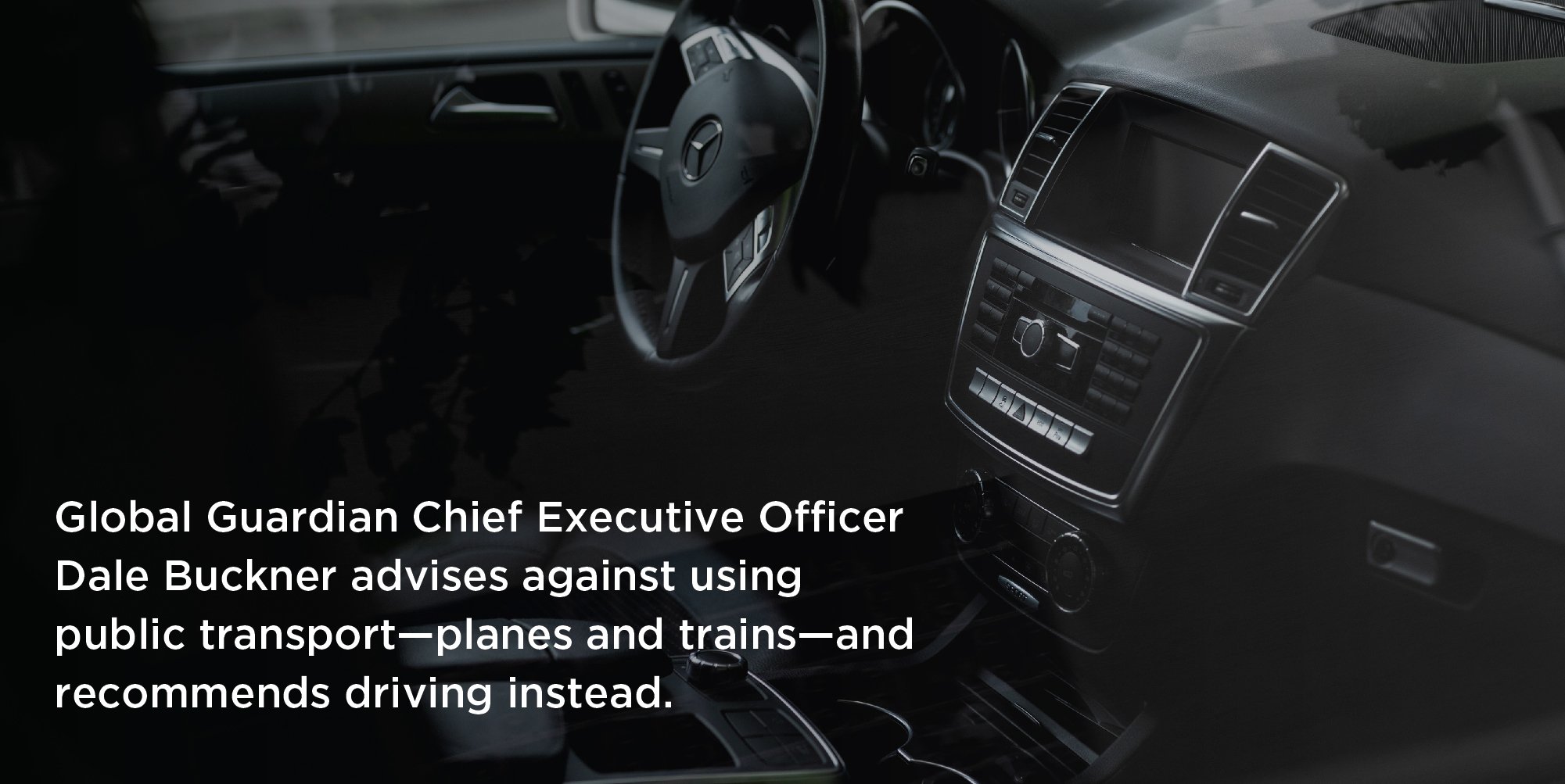
The next question to consider is how you will get to your meeting. Buckner advises against using public transport—planes and trains—and recommends driving instead. Driving, however, does not eliminate risk. You will likely stop to eat, use the restroom, and buy gas. Wearing a mask, handwashing, and social distancing are critical during these times, says Buckner.
Q: What do I need to consider while planning summer vacation travel in the United States?
As families plan their summer vacations it is important to be aware of travel restrictions before hitting the road. Connecticut, New Jersey, and New York, for example, have jointly agreed to restrict the entry of residents from states that have high rates of COVID-19 infections. These states don’t want people from high-positivity states “coming on vacation to go to the Hamptons, Long Island, Jersey Shore,” says Mike Ballard, Director of Intelligence at Global Guardian. State troopers positioned on bridges and causeways leading into popular summer vacation spots are on the lookout for out-of-state plates. Massachusetts, too, has similar restrictions in place. Travelers from high-risk states are required to quarantine for 14 days after leaving their state.

Q: What precautions do I need to take when I travel?
Basic health and safety precautions—handwashing, social distancing, and wearing masks—should be followed at all times. When it comes to planning your trip, Christopher N. White, Assistant Medical Director at Global Guardian, recommends carefully studying your route, travelling during off-peak hours, using less-crowded back entrances of buildings, and carrying adequate supplies of hand sanitizer, disinfectant wipes, and masks.
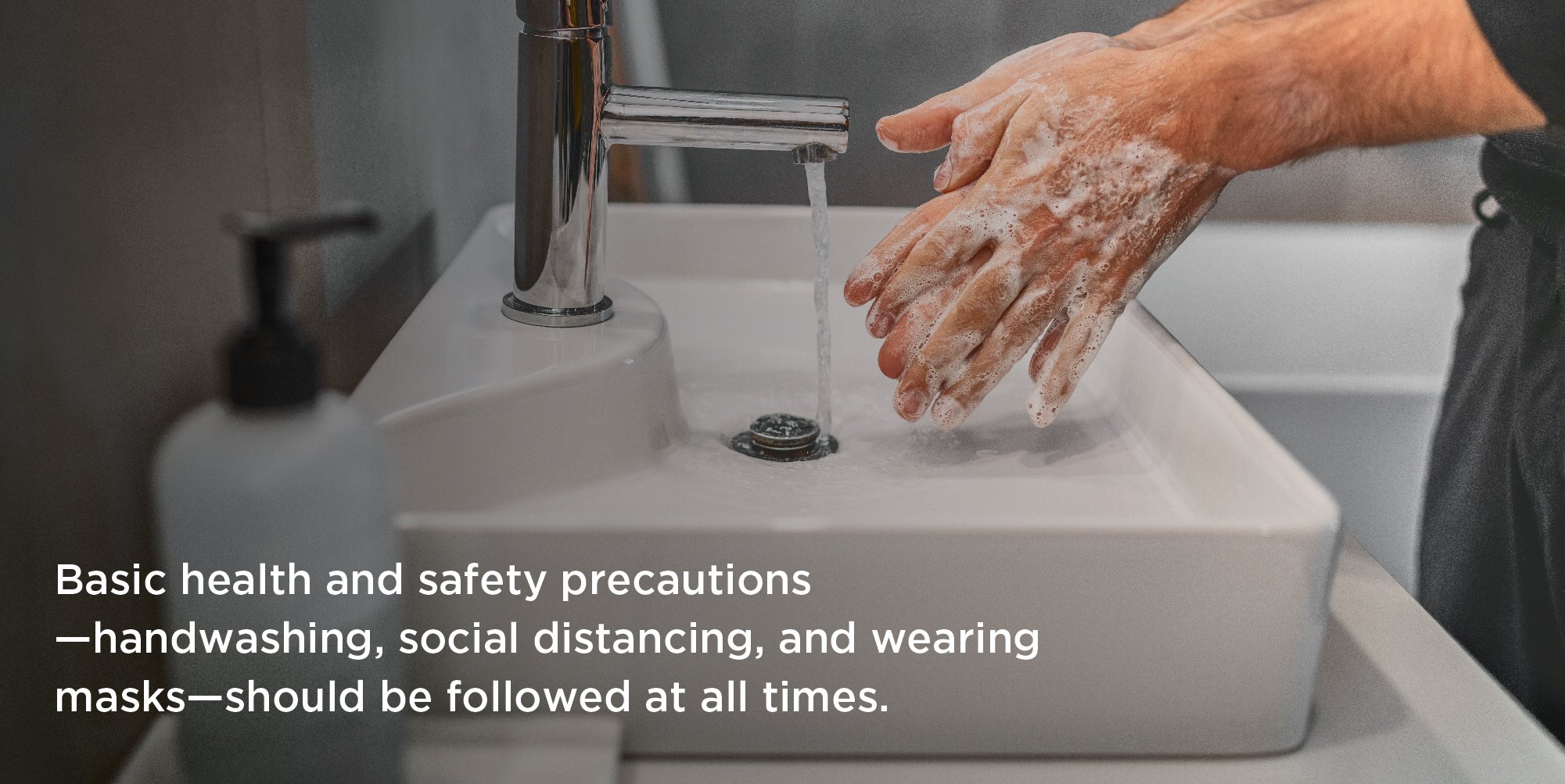
Q: When can we expect a COVID-19 vaccine?
A worldwide effort is underway to develop a vaccine for COVID-19. Some efforts are showing promise. A vaccine developed by biotechnology company Moderna in partnership with the National Institutes of Health has shown positive results. And scientists at Oxford University say their experimental vaccine has prompted a protective immune response in hundreds of people who were given the shot in an early trial.
In anticipation of a vaccine, countries are preparing the ground for purchase and distribution. The European Union is reportedly in talks with drug makers Moderna, Sanofi, and Johnson & Johnson, as well as biotech firms BioNtech and CureVac to make advance purchase deals of a possible vaccine. In the United States, Operation Warp Speed, a partnership among components of the Department of Health and Human Services and the Department of Defense, “aims to deliver 300 million doses of a safe, effective vaccine for COVID-19 by January 2021.”
Shelly Weisenfeld, Medical Director at Global Guardian, predicts a vaccine will likely be available in early 2021. But she is cautious. “We have to keep in mind that the first vaccine that is out of the gate may not be the one that is ultimately used for wide distribution,” she says.
Developing an effective vaccine is critical to getting humanity back on the path to normalcy. “We simply don’t think we can get this back in the box until we get a vaccine,” says Global Guardian Chief Executive Officer Dale Buckner.

Q: What are the barriers to vaccine adoption?
Once a vaccine is developed, adoption will be key. Shelly Weisenfeld, Medical Director at Global Guardian, says “significant barriers exist in educating the public on the utility of vaccinations.”
“This is exemplified with knowing that only 50 percent of Americans actually get the influenza vaccine,” she says.
Weisenfeld, who has a Master’s in Public Health from San Diego State University, says: “After science proves the safety and effectiveness of a vaccine, the vaccination process needs to overcome several obstacles.”
As a result, she says: “The need to ensure access with widespread community strategies that are focused on education is essential. Such will need to motivate a better public health awareness and the discrimination of information tools. There is also a great need to diminish fear of side effects as well as encourage the belief that vaccinations assist in the protection of self, family, and workplace.”
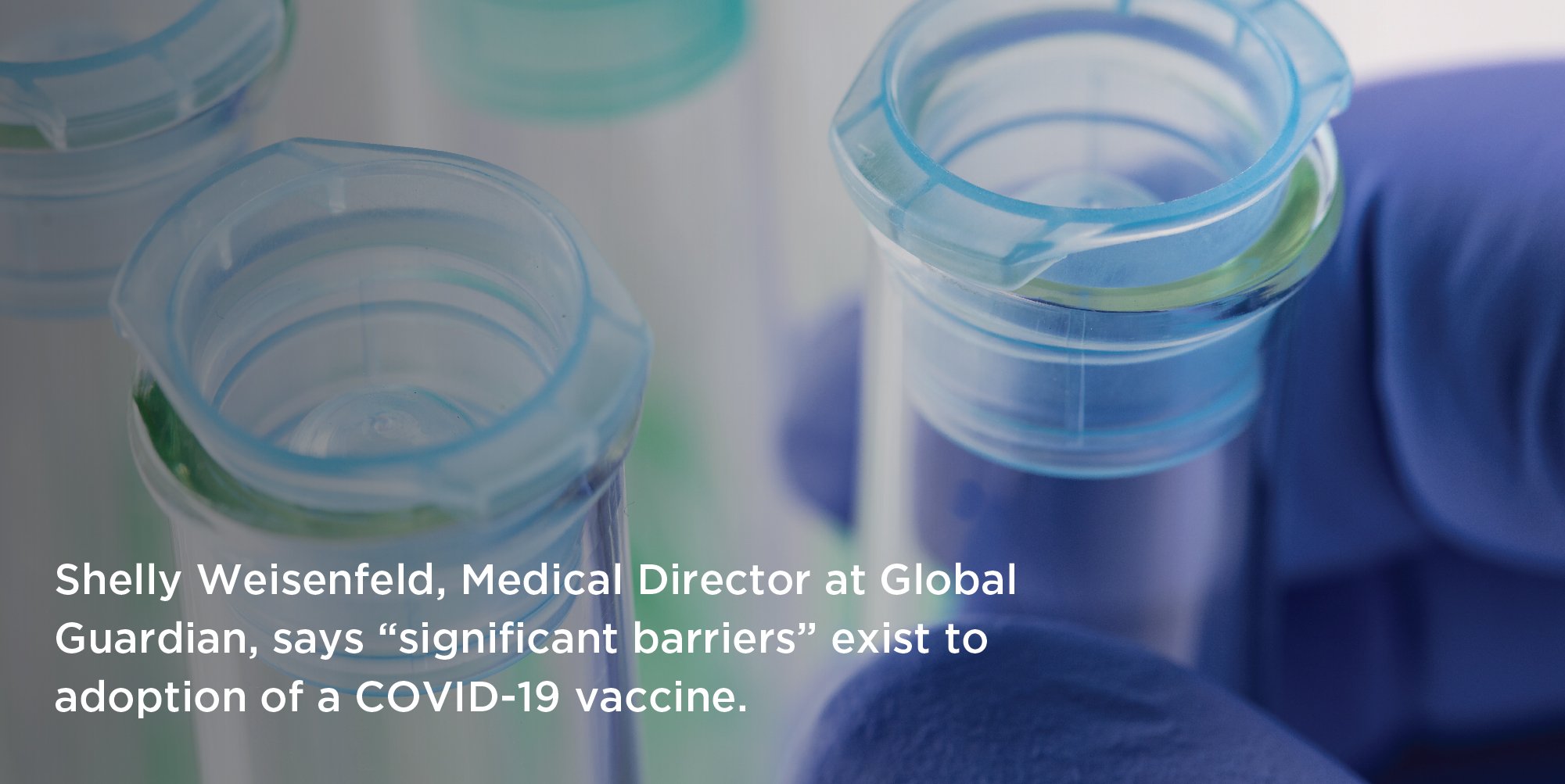
Q: Will a vaccine boost international travel?
Shelly Weisenfeld, Medical Director at Global Guardian, says this is not an easy question to answer. Even if a vaccine is available in the United States, international travel is unlikely to bounce back to pre-pandemic levels until it is available and adopted worldwide. There are many factors to consider with regard to having a safe and effective vaccine, says Weisenfeld, and countries will have their own playbook for adoption.
“The vaccine itself is not a cure and it’s not treatment,” says Mike Ballard, Director of Intelligence at Global Guardian. “Even if it has been proven safe and effective, until people who are traveling actually have it I don’t think it really changes anything. It needs to actually be deployed.”

Until that time, Weisenfeld advises international travelers should be ready to pack a good dose of flexibility.
Ballard says just as some countries require travelers to produce proof of vaccination for yellow fever, until there is a similar requirement for proof of a COVID-19 vaccination not much is likely to change in terms of the pace of foreign travel.
Q: Will mutations in the coronavirus complicate the development of a vaccine?
The novel coronavirus is a single-stranded RNA virus. This means that it is more fragile and susceptible to mutations than the double-stranded DNA virus. Shelly Weisenfeld, Medical Director at Global Guardian, says it is highly likely that these mutations will make it difficult to produce a perfect and enduring vaccine. “We know the vaccine composition of influenza (also a RNA virus) is based on the prior surveillance of circulating virus with best attempts to predict the upcoming strain,” she says, adding, “We can expect that similar deliberation with the coronavirus.”




